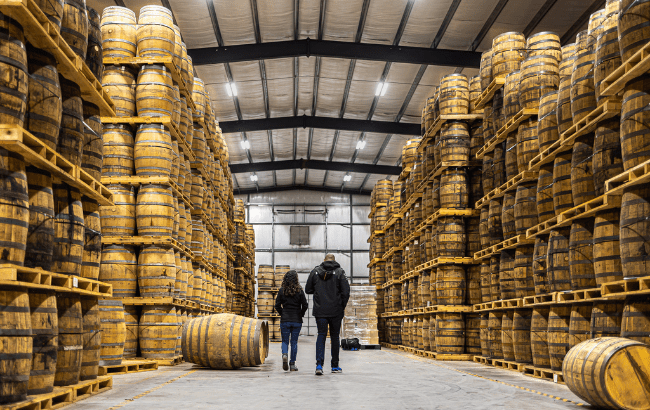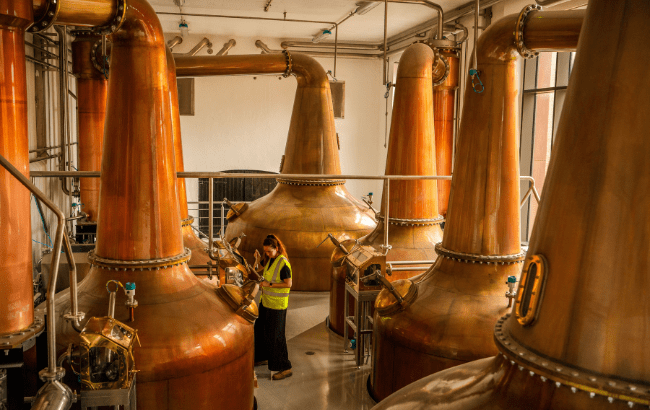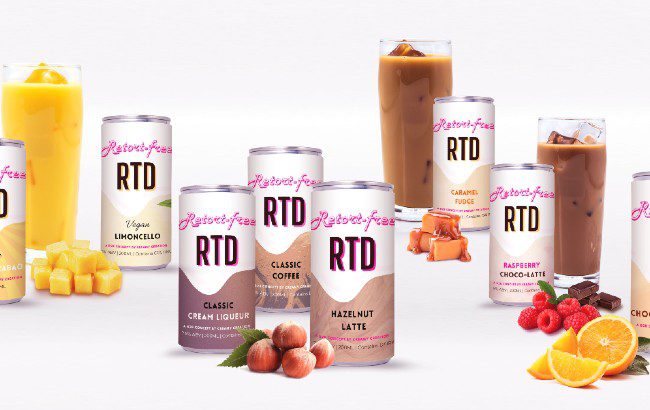The change in demand for third-party spirits
By Tom Bruce-GardyneFrom gin softening to other categories showing resilience, myriad factors have contributed to a change in demand for third-party spirits.

*This feature was originally published in the March 2025 issue of The Spirits Business magazine.
Third-party-spirits suppliers such as London’s Thames Distillers played a crucial role in fuelling the great early 21st-century gin boom. A category of just a few big names, long dominated by Gordon’s in the UK, exploded into a profusion of new brands, many of them supplied by Thames Distillers. But now, as its managing director Charles Maxwell ruefully concedes: “It’s not as booming as it was. It’s settling back after the glorious days of pre-Covid, when it was going like an absolute steam train.”
Looking at the global gin market, he gives a quick assessment of the past 12 months: “The key markets of Spain and the UK are distinctly down. The US is fairly flat. Italy and Eastern Europe are still showing a bit of growth. The Far East is still interesting, and there’s a bit going on in South America and Turkey.”
By price band, he reckons the top-end was “holding its own, certainly until the second half of 2024”, but now seems to be suffering due to the squeeze in disposable incomes.
He claims to have been “slightly surprised” by the resilience of some of the smaller gin brands he supplies. “But when they’ve got a good story and the product’s good, they can still find a place in the market,” he says. Among them are a few new brands that are managing to acquire distribution even now. “In the first half of last year, a lot of the wholesalers were saying they couldn’t take any more gins,” he says. “But the surplus has been cleared out.”

Part of the story
In Maxwell’s view, the gin category suits the third-party model because provenance is rarely the deciding factor. “Where your gin is made is one of the lower parts of your marketing,” he claims. “It’s part of the story, but it’s seldom a major part.” Arguably, the same could be said of Irish whiskey, or at least that large chunk of the category supplied by contract distillers.
Foremost among them is the Great Northern Distillery in Dundalk, the biggest Irish whiskey producer after Pernod Ricard, which has the capacity to fill up to a million bottles a week. Its chairman and co-founder, John Teeling, says: “The number of Irish whiskey brands has gone from five 40 years ago to probably 600 to 800 worldwide. That has settled down, and is perhaps in decline as a lot of people set up more in hope than expectation. The focus for the Irish had been totally on the US.
“We share a culture, a language, and an awful lot of blood with the diaspora. And with the success of Jameson, there was a huge rush of importers looking for brands. You also have quite a number of companies with trophy brands tied to celebrities or rich Irish-Americans who want to have a whiskey.”
The strong year-on-year growth in US shipments over the past two decades fed a surge in production. Today, Teeling reckons “there are probably 46 distilleries, and probably another 200 to 300 branded companies,” selling Irish whiskey. Great Northern is involved in both sides, from providing new-make grain spirit to malt distillers that want their own blends, to supplying fully matured whiskey for others to sell and market. The finished product can be fully bespoke.
“The biggest single asset of Great Northern is the recipe book, and any brand has its own unique recipe,” he says.
In 2023, the American thirst for Irish whiskey took a dip, with volumes down by 22% to 4.7 million cases year on year, while value dropped by 20% to US$1.1 billion in 2023, according to the Distilled Spirits Council of the US. That year, US shipments shrank by 14% (Bord Bia data), though they bounced back by 11% in 2024. For the industry it was a wakeup call to develop new markets – a feeling heightened by president Donald Trump’s threatened tariffs.
Luckily, “central and Eastern Europe has been a huge growth market”, says Teeling. “as has own-label, especially in Polish supermarkets. There’s a company in Italy selling Irish whiskey into Eastern Europe, and probably Russia too, though I don’t want to know about that.”

He appreciates that many of his customers dream of making their own whiskey, but says: “Our mantra for 20 years has been – you don’t need a distillery to have a brand.” Interestingly, Teeling appears to have no interest in the latter when it comes to his own business. “The current fortune of Great Northern is we’re whiskey only, with no idea of going down to brands or bottling,” he says. “I had a long and difficult experience at Cooley with that.” He founded the Cooley distillery in 1987, which was sold to Beam Inc (now Suntory Global Spirits) in January 2012.
Meanwhile, MGP Ingredients, which has long been the leading third-party supplier for American whiskey through its Distilling Solutions division, has moved in the opposite direction. In November 2024, after posting a 24% third-quarter net sales drop, within which Distilling Solutions fell by 36%, the firm said it would focus on branded spirits in 2025, and cut whiskey production. In October, according to The Wall Street Journal, it revealed that some of its smaller customers were struggling to make good on their obligations to buy whiskey. MGP, which is subject to a class-action lawsuit for failing to disclose market realities, including oversupply and declining demand, did not respond to requests to comment for this article.
Jerry Heddy, chief operations officer at American Custom Distilling, claims the third-party US whiskey market has fragmented considerably. “MGP is not the ‘go-to’ anymore,” he says. “You have a lot of other players like Bardstown, Whiskey House of Kentucky, Eastern Light Distilling, and a lot of new upstarts that have taken away market share from MGP.” His company, which is wholly owned by the Virginia Distillery Co, is the largest supplier of American single malt whiskey. With its copper pot stills and ageing stocks of refill barrels, it would not look out of place on Speyside. The aim is to be as accessible as possible to potential customers. “You don’t need to place an order for 500 barrels; we’ll take an order for 25,” says Heddy. “So, it’s a much lower barrier to entry and I think that will enable a whole new set of entrepreneurs.”
There is undoubted interest in US single malts, a category that was only signed into law in December, and he sees it as a way for brand owners to diversify beyond Bourbon, which is in serious oversupply at present.
Matthew Benny, chief commercial officer, the Americas, at business-to-business cream liqueur maker Creamy Creation, is well aware of the current volatility in the market. “You see the doom and gloom in the news with the industry really having a tough time,” he says. “We’ve seen a slowdown but our business has been stable. Cream liqueurs seem to somehow cut through the noise.”
The number of business enquiries his company has received has also remained constant. “We work with multinationals and craft distillers – everyone across the board,” he says, “and there’s always been a pretty consistent group of entrepreneurs with industry experience, or sometimes with none.” He feels innovation in the category “has started to slow down a little bit. People are not as open to new-to-the-world things right now.”
Innovation has typically been driven by smaller players, like the Misunderstood Whiskey Company, which recently teamed up with Creamy Creation to create Oatrageous for non-dairy consumers. Oatrageous is a good example of a small, entrepreneurial company prepared to take risks that bigger, more established players can find difficult.
And while retailers may be tempted to play safe, Benny believes: “They’re still willing to give something space, especially if they see value in it, and there’s consumer interest and it follows the trend lines.”
Third-Party RTDs

“We don’t make RTDs, but we make the concentrated spirit flavour to go into them,” says Charles Maxwell at Thames Distillers about customers trying to develop such brands. “One of the biggest obstacles used to be the canning companies who’d say ‘unless you’re going to give me 100,000 units, I’m not really interested’. But there are now contact canners out there who’ll work in much smaller volumes.”
In Ireland, vodka-based ready-to-drink (RTD) products saw exports treble in value last year to €235 million (US$242m), with approximately 90% of all RTDs going to the US. With whiskey the big brand is Jameson’s Ginger & Lime, but third-party suppliers have also been getting involved. “We’ve got two particular companies we supply – Two Stacks, and Egan’s, who do a huge number of RTDs into Japan,” says Great Northern Distillery’s John Teeling.
Creamy Creation’s Matthew Benny says: “For cream-based RTDs, I think people still look at the classic cocktails. There’s a tonne of Espresso Martinis, and Grasshoppers, Piña Coladas, White Russians, and Mudslides. We have definitely launched more RTDs in the last few years, than in the past 10 or 20 combined.”
And while there used to be volume issues around cans similar to those in the UK, things have eased. “There has been a lot of investment recently, in fact, over-investment,” says Benny. “So, there’s plenty of canning capacity.”
Related news
Contract thriller: third-party spirits
